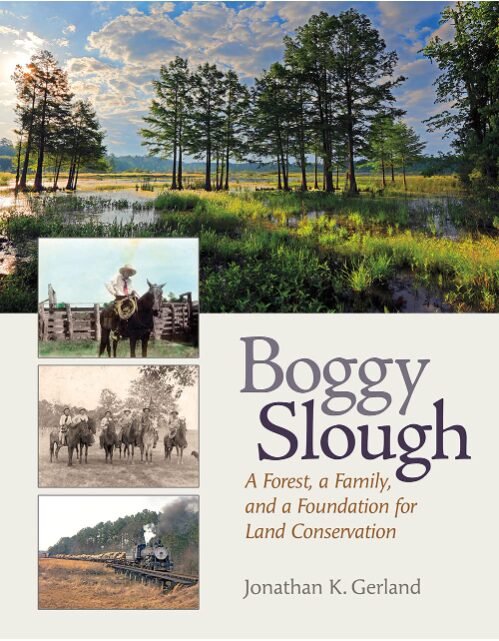In case you have not heard, East Texas has another great book available on its early history: Boggy Slough, a Forest, a Family, and a Foundation for Land Conservation. The author is the Executive Director of the East Texas History Center and Lufkin native, Jonathan Gerland.

Gerland’s book chronicles the natural, cultural, and business history of the 19,000 acres just west of Angelina County known as Boggy Slough. This tract of land is in both Houston and Trinity Counties and is exactly across the Neches River from Angelina County.
While the significant thrust of the book is on forestry, business endeavors, people, and natural resource management, I found the early land management and food production efforts quite interesting.
I’ve been intrigued by the early land crops, usage, and early land management tools. As an overarching historical account should do, the book starts with pre-historical account and takes the reader through changing management ideas and leads us up to the present state.
You’ll find discussion of early settler food crops that include corn, Irish potatoes, sweet potatoes, peas, beans, squash and more. Commercial crops such as tobacco and cotton were utilized along the wool, butter, livestock production, and, of course, lumber. Early explorers and settlers saw a much different landscape that what we see today.
In 1687, explorer Jean Cavelier (brother of well-known French explorer LaSalle) reported that his Hasinai Caddo escorts took him over “as well a beaten road as that from Orleans to Paris” in his native France. He stated that for a distance of 50 miles, woodlands were almost unnoticeable. He continued, “we rode the whole way though beautiful and vast prairies.” This well-beaten road was located between villages along the Neches and Angelina Rivers. Over a century later in 1821, Stephen F. Austin noted the “handsome smooth prairies” with “very little undergrowth” on his travels just west of Nacogdoches.
Starting at the beginning, the Caddo Indian tribes used fire as a tremendous tool to shape and manage the vegetation. Their management of native fruit crops was a wonder to the early explorers. One of the many topics I have found interesting is the discussion of early food production by both native Americans and the earliest settlers. The Hasinai Caddo had a fruit and nut crop of which any modern orchardist would be jealous.
During his travels in 1691, Fray Francisco Casanas de Jesus Maria listed several species and varieties of fruits and nuts. Walnuts, pecans, blackberry, and numerous grapevines were listed. Later in 1716, other Spanish explorers added to the list. These included persimmon, plum, wild cherry, red and white
mulberries, chinquapin, mayhaw, elderberry, and more. Vegetable gardeners would be interested to learn about the methods the Hasanai used in “gardening” their corn, beans, squash, melons, and sunflowers.
This Tuesday, April 19 starting at 6:30 pm, the Angelina County Extension Office will be hosting Jonathan Gerland as a speaker. His topic is “Horticultural practices by Caddo Indians and early settlers in East Texas.”
There is no fee. Books will be available for purchase. For more information call 936.634.6414.
Cary Sims is the County Extension Agent for agriculture and natural resources for Angelina County. His email address is cw-sims@tamu.edu.
Educational programs of the Texas A&M AgriLife Extension Service are open to all people without regard to race, color, sex, disability, religion, age, national origin, genetic information or veteran status. The Texas A&M University System, U.S. Department of Agriculture, and the County Commissioners Courts of Texas Cooperating.








